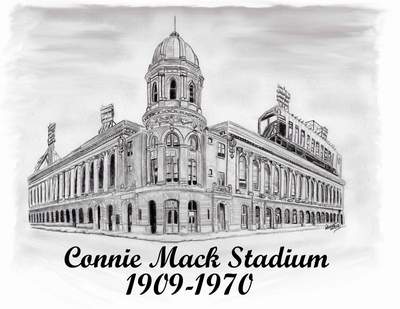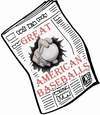|
Connie Mack Stadium Drawing by Steve Ramer Watch a short video about Connie Mack Stadium Connie Mack Stadium, originally named Shibe Park, opened on April 12, 1909 in Philadelphia. It was the new home for the Philadelphia Athletics. Like so many other baseball parks of that day, Connie Mack Stadium was built with concrete and steel, at an original cost of $300,000. Athletics owner Ben Shibe decided to build the new baseball stadium to attract fans away from their cross town rival Philadelphia Phillies. Shibe Park was known for it's impressive, French Renaissance outside facade. Built of bricks and concrete with a tower at the main entrance. Originally the ball park seated 23,000 fans. 10,000 standing room "seats' were usually available in deep center field. The double decked grandstand wrapped around home plate where the bleachers then extended down the foul lines. Buildings behind the 12 foot right field fence offered local fans a free view of the action from the roof tops. Much like at Chicago's Wrigley Field. Connie Mack Stadium was much bigger than most baseball stadiums of it's time. Mostly because there were not many buildings in the area. 378 feet to left, 340 to right and a distant 512 to deep center field were considered enormous distances then. In 1925, major renovations took place. A roof was added to the rest of the grandstands and a "mezzanine" was installed by 1930. This made the total seating capacity 35,000 fans. Fans on the roof tops on the other side of 20th Street had a great view of Connie Mack Stadium. The mistake they made was, they built a few sets of bleachers on the roof and were charging admission. New owner Connie Mack, sued the building owners over this in 1935, but he lost his case. Instead, he had a the outfield fence raised to prevent the fans across 20th Street from seeing the games. On May 16, 1939, the first night game was played at Shibe Park. The Philadelphia Phillies baseball stadium was Baker Bowl. On July 4, 1938, the Phillies moved into Shibe Park. In 1953, Shibe park was re-named Connie Mack Stadium after the Athletics owner/manager of 50 years, Connie Mack. After the 1954 season, the Philadelphia Athletics moved to Kansas City and the Phillies were able to purchase Connie Mack Stadium for $2 million. A huge new, 60 foot high score board was put up and plexi glass now protected fans behind home plate. By the mid 1960s, Connie Mack Stadium was in strucural decline. The city of Philadelphia put a "bond issue" on the ballot for a new, all purpose stadium that would be home to both the Phillies and the Philadelphia Eagles of the NFL. The measure was approved and plans were made for the new stadium. On October 1, 1970, the last game was played at Shibe Park/Connie Mack. In 1971, the Phillies and Eagles moved into fabulous Veterans Stadium. This classic, old baseball stadium was not torn down immediately. It stood for several years. Fire destroyed part of it in 1971, and it was turned into a junk yard in 1974. Finally in 1976, the rat infested Connie Mack Stadium came down. A church now occupies the site that saw so many Philadelphia sports memories. Connie Mack Stadium Dimensions: By the end of Connie Mack Stadium's time in Philadelphia, the left field line ran 334 feet. The left center field power alley was at 380 feet and straight away center stood at 410. Deep, right center was 390 feet from home plate and the right field foul pole stood at 329. Memorable Moments: Two Major League Baseball All Star games were held at Shibe park. 1943 and 1952. Eight World Series were played (A's and Phillies). The last one in 1950. The New York Yankees beat the Phillies' "Whiz Kids" four straight. On September 24, 1940, Jimmy Foxx of the Boston Red Sox clubbed his 500th home run at Connie Mack Stadium/Shibe Park. In a game on June 3, 1932, Yankees first baseman Lou Gehrig hit four home runs.
|



 Sign Up For My Free Newsletter!
Sign Up For My Free Newsletter!